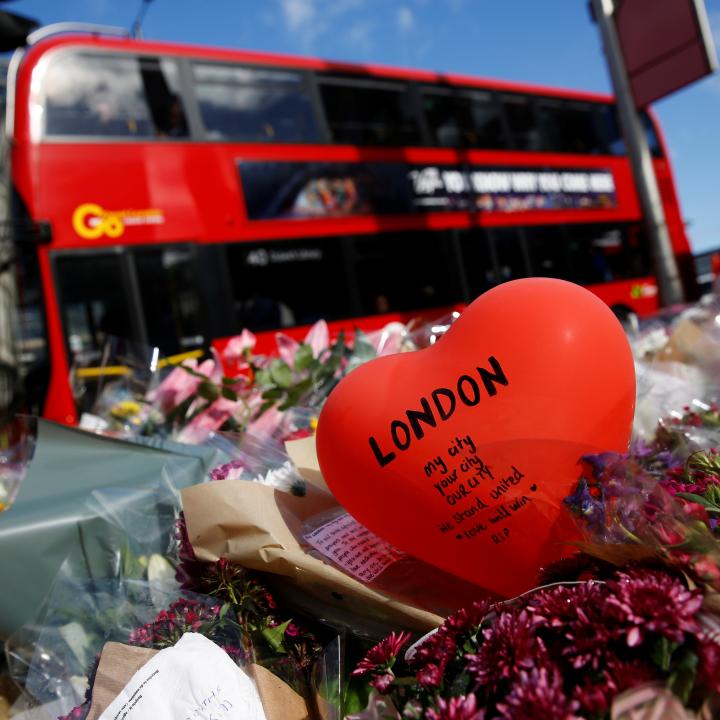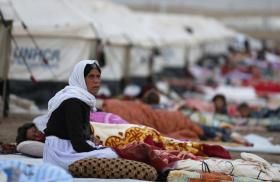

Part of a series: Counterterrorism Lecture Series
or see Part 1: U.S. Efforts against Terrorism Financing: A View from the Private Sector
Watch European and American policymakers discuss how the West is confronting a new generation of Islamist-inspired violent extremism.
On June 16, Dick Schoof, Muhammad Fraser-Rahim, Farah Pandith, and Matthew Levitt addressed a Policy Forum at The Washington Institute. Schoof, whose remarks are posted separately, has served as the national coordinator for security and counterterrorism in the Netherlands since March 2013. Fraser-Rahim is the executive director, North America, for the London-based counterextremism think tank Quilliam International. Pandith is an adjunct senior fellow at the Council on Foreign Relations who also serves on the Department of Homeland Security's Advisory Council, where she cochairs the CVE Task Force. Matthew Levitt is the Fromer-Wexler Fellow and director of The Washington Institute's Stein Program on Counterterrorism and Intelligence. The following is a rapporteur's summary of their remarks.
Muhammad Fraser-Rahim
Extremists are adapting and learning more effectively than ever before. Indeed, counterterrorism analysts have noted the evolution from large-scale spectacular attacks to low-tech, high-impact strikes. Yet while countering violent extremism is a mighty challenge, officials and analysts must be very careful not to confuse such extremism with Muslim beliefs.
For definitional purposes, Islam is a worldview, a value system, and a belief system practiced by some 1.5 billion Muslims across the globe. Islamism, by comparison, is a political ideology that supports a draconian interpretation of Islam that is narrow, rigid, strict, and mostly legalistic. Islamism has modern manifestations throughout the world. Some Islamist groups serve as gateways to more violent organizations, including terrorist organizations. Such groups can -- if left unchecked -- lead people down the path to extremism to groups like al-Qaeda, al-Shabab, Boko Haram, and the Islamic State. Islamists envision a mythical, theocratic pan-Islamic state that, frankly, never existed and exploit that idea to mobilize people to violence. Islamist ideology, combined with Salafi theology, effectively creates the modern manifestation of Salafi-jihadism.
So what needs to be done? Violent extremist ideology must be isolated from mainstream Islam. Who can do that? In the view of many, challenging and changing the radical narrative cannot be accomplished by secular individuals alone. The most effective voices to counter Salafi extremism are those of devout, practicing Muslims who see this issue as a cancer within their faith. Here in the West, individuals and institutions must challenge those texts and ideas that foster repugnant, misogynistic, or violent ideas. These may be legally protected ideas within Western democracies, but people must nevertheless fight the ideology and taboos just as they would fight homophobia, racism, and other destructive "isms."
Farah Pandith
One must be frank in asking why, sixteen years after the 9/11 attacks, the same challenges of extremism and terrorism have recurred over and over again. Indeed, the issue is hardly limited to the Islamic State -- it is far greater than that.
Further, what counterterrorism experts learned about a decade ago, when they first began examining the ideology of extremist groups, still applies today. Local solutions are the answer, credible and valid influencers can make a difference to their peers, and government has a very limited role to play. Returning to these basics is necessary to achieve progress in countering extremist ideology.
In applying these basic principles, officials must cultivate networks of like-minded thinkers who are schooled in the latest technologies and can saturate communication channels with alternative ideas to counter those peddling in extremism. Relatedly, government money was insufficient a decade ago to help grassroots NGOs on the frontlines, and it surely remains insufficient now.
Today, one billion young Muslims throughout the world are younger than thirty. (The roughly 1.6 billion Muslims worldwide constitute about one-fourth of humanity.) That is the pool from which groups like the Islamic State recruit. By 2030, the world's Muslim population will have grown to 2 billion, meaning that a failure to comprehensively address the root causes of Islamist extremism will require the same soul-searching in a decade in which society is engaged now.
Returning to the basics, and employing lessons learned over the past decade, will indeed require funding so that a plan can be executed at an appropriate scale. Small pilot programs around the world will not be enough to compete with IS and similar groups. The United States, one could persuasively argue, has not yet even tried to go "all in" with such an approach. With determination, a strategy can succeed if it is both kinetic and nonkinetic, brought to a greater scale, and fundamentally serious.
Matthew Levitt
In looking ahead to the defeat of the Islamic State and the so-called caliphate in Syria and Iraq, analysts and officials must also take a step back. Even as the jihadist group loses territory and suffers battlefield defeats, the threat it poses in the region and around the world remains acute.
The first related serious problem involves returning terrorist fighters, especially in Europe, where hundreds of the several thousand foreign fighters have already come back. Even with the best intelligence, the use of very high-quality false documents to reenter Europe means that authorities will be unable to identify all returnees. Indeed, Britain has already reported people attempting to return with such sophisticated false documents.
In the United States, the returning foreign terrorist fighter threat is nowhere near the scale of that in Europe -- American has only about three hundred fighters who either traveled abroad to Syria, Iraq, or Libya or attempted to do so -- but over the next five to ten years, the release of hundreds of convicted terrorists from U.S. prisons will change the situation. The United States does not have countering violent extremism programs as such within its prisons, nor does it have CVE programs built into its probationary systems, aimed at helping people reintegrate into society. This is why the United States, too, could face a threat on a scale similar to that in Europe. Notably, the first woman convicted on charges related to the Islamic State is expected to be released very soon.
Getting ahead of the radicalization curve requires localizing efforts to the greatest extent possible. Moreover, the most effective figures for countering the future lure of terrorism will not be analysts or officers; they will be clinical social workers, psychologists, and teachers. These frontline professionals, through their early involvement with at-risk individuals, can help prevent radicalization before it takes root. Such a local strategy can stop the mobilization of many other extremist ideologies as well. All in all, any approach to radicalization must have a whole-of-society orientation, while complementing existing counterterrorism efforts by government officials.
The most daunting obstacle to success is inadequate funding for local, community-led CVE initiatives. The federal government cannot and should not be the only funding source for such endeavors. Civil society and private companies must also bear some of this financial responsibility, because the threat of violent extremism affects everyone, justifying the whole-of-society -- not only a whole-of-government -- approach. Generally, efforts should move from the bottom up, not the top down.
Meanwhile, law enforcement and intelligence agencies are clamoring for local networks with which they can partner to address cases of radicalization that fall below the legal threshold for prosecution. Time and again, it turns out that people who end up carrying out attacks had previously crossed the radar of law enforcement. In many of these cases, the suspects were investigated, yet officers ultimately determined their behavior was disturbing but in no way illegal.
In a democratic society, radical thought should not be criminalized but related ideas must be challenged. And when law enforcement officials encounter individuals espousing such dangerous but protected ideas, they must have in place local networks of social workers, psychologists, and others as ready partners. Then, when a future Orlando shooter comes along showing disturbing but not illegal behaviors, the FBI or local law enforcement will have in mind someone or some group to which it can hand off the case.
This summary was prepared by Nicolette San Clemente.










